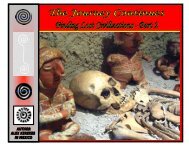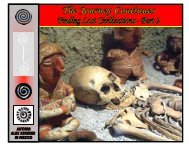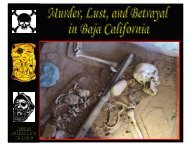FINDING LOST CIVILIZATIONS This
FINDING LOST CIVILIZATIONS This
FINDING LOST CIVILIZATIONS This
Create successful ePaper yourself
Turn your PDF publications into a flip-book with our unique Google optimized e-Paper software.
Chapter 13The Trees and Relics ofSan Pedro LagunillasIt is interesting how we often go about our daily life withoutnoticing the beauty or history around us. Two eventsoccurred in the town of San Pedro Lagunillas that remindedme that there is always something to behold around us. <strong>This</strong>was the third trip my father and I had made to this smallfarming community. The population of the town is aboutthree thousand people with another eighteen hundred of thetownspeople working in the United States. It is an old townand dates back to the sixteenth century when the Spanishsettled this area.On this day we were visiting the town with our friendRafael, who was considering buying a lot to build a smallhome. While in town we met the landowner, Andres Torres,who led us through town as we walked to his hilltop property,which had originally been called Loma De San Sebastianbut was now referred to as Loma Linda. Near Andres’ propertywe came upon a small town square, which I had passedunnoticed during my two previous visits. Andres stopped usand pointed out three lone trees in the park. He told us thatthose three trees were the only ones in existence on this continentthat dated back to the sixteenth century and that thosetrees were the type that existed in Jerusalem during the timeof Christ. Interestingly, there is a reference among Christianwritings that Jesus was crucified on a cross made of woodfrom the Terebinto tree. Andres then pointed to a small signpainted in black and white bearing an inscription in Spanish,which explained the origin of the trees. According to thesign the trees were known as Terabit (Pistacia terebinthus)and were living fossils. Legend has it that a religious mannamed Bernardo de Balbuena brought these trees to San PedroLagunillas in the sixteenth century. Apparently, duringthat time this location was the only place in the New Worldwhere these trees were able to flourish. Later, I learned thatBalbuena was born in Valdepenas, Spain, around 1561, andcame to the New World at the early age of two and lived in61







